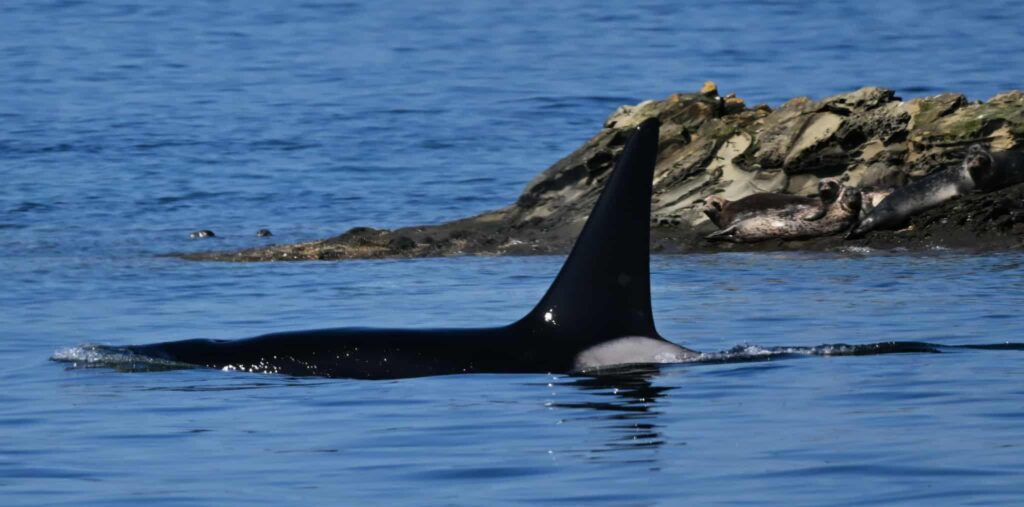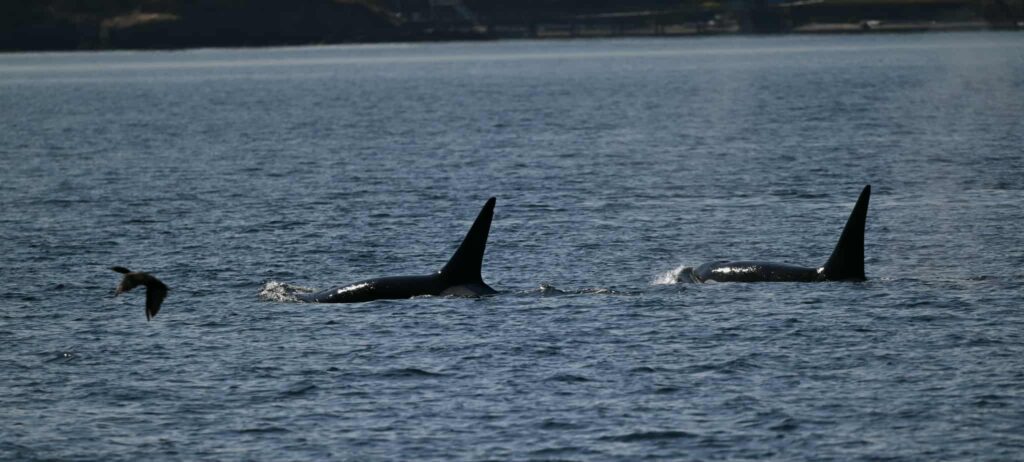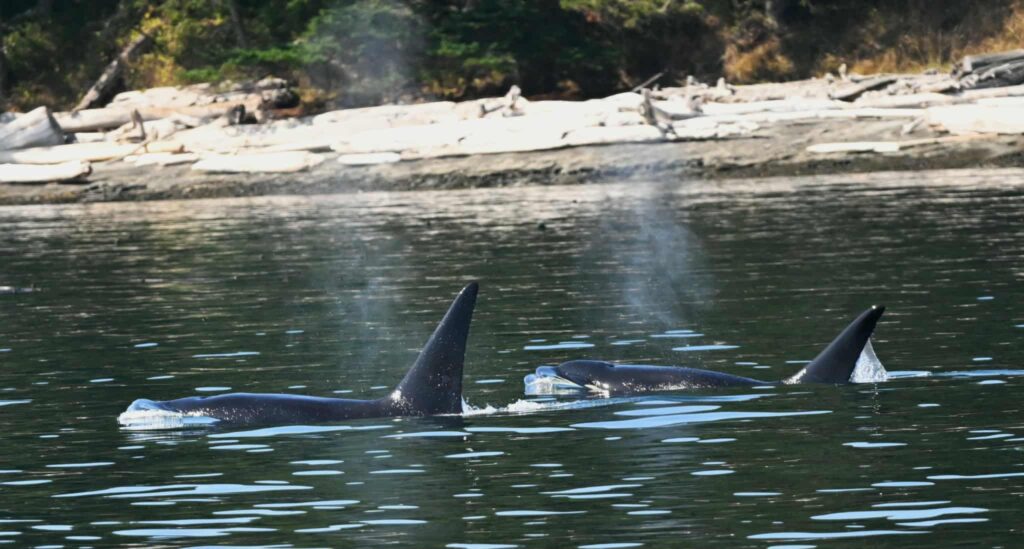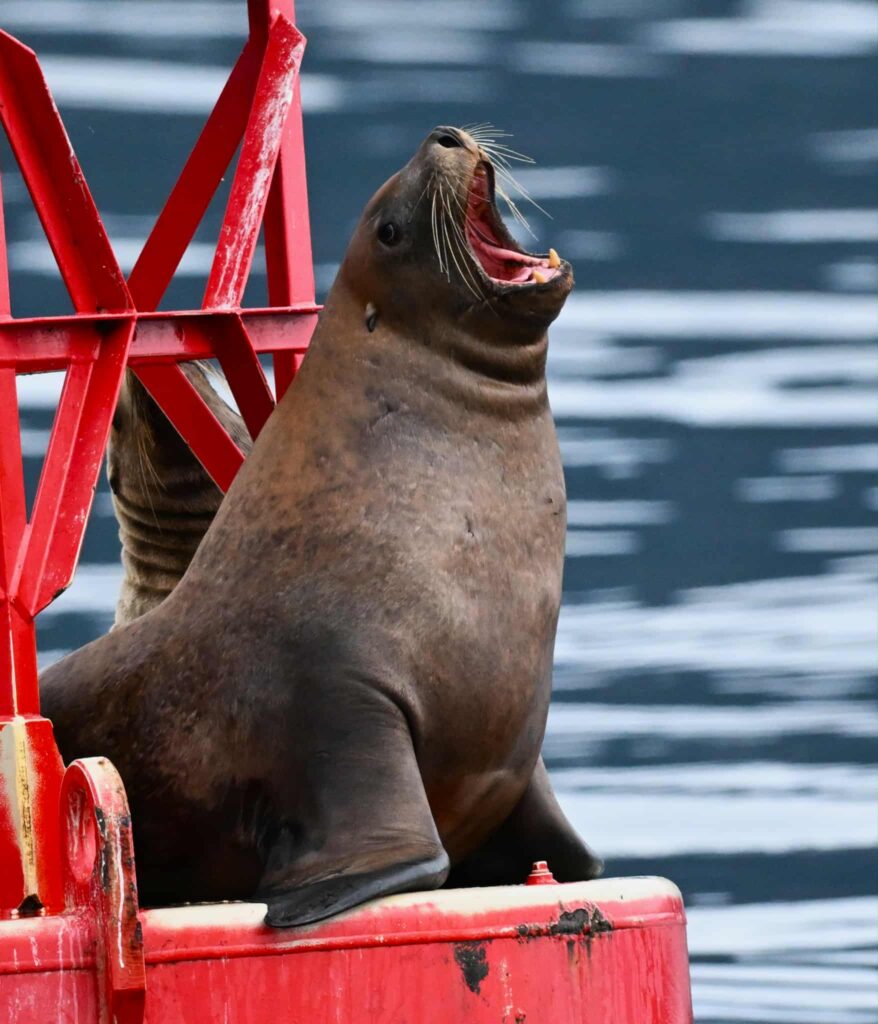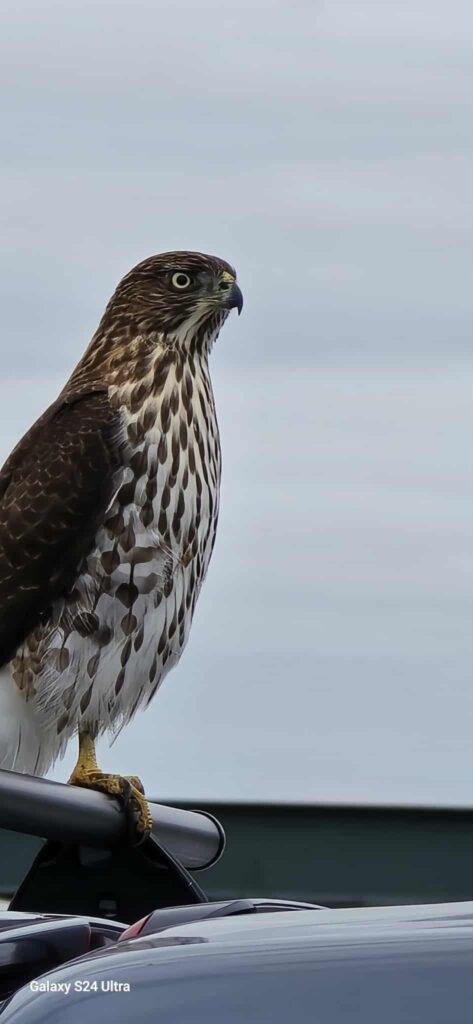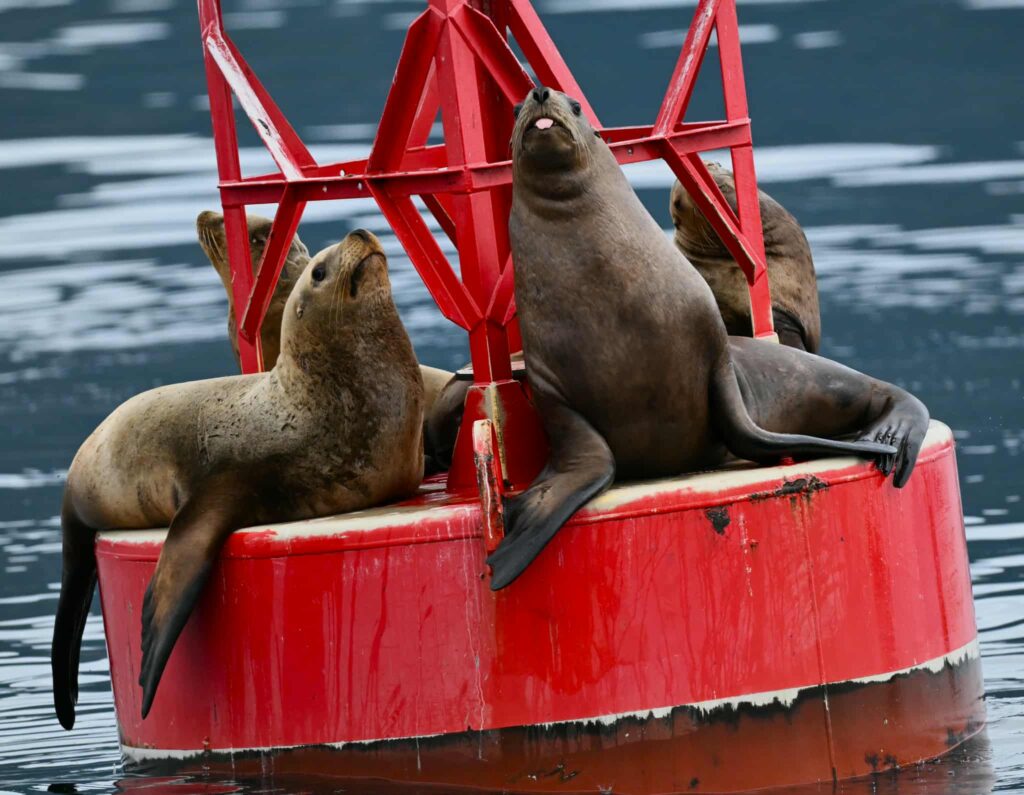Biggs orcas T60D&E – Onca and Lynx, Vocal Stellers, and a Cooper’s Hawk on 9/13/25 by Kurt Leipold
Sept 8th
The overcast morning started with no reports, so we decided to wait to plan our route once we got to Viti Rocks in Rosario Strait, our go-to first stop for wildlife. As we arrived there was a report about a humpback whale path south of Lopez Island. We traveled down Bellingham Channel and saw lots of harbor porpoise. The small dark cetaceans that are notoriously boat shy, so it’s moot to look for them.
We got to McArthur bank out in the main straight, searching for the humpback. and we eventually found Victory! This whale has been hanging around and feeding in this particular spot for a couple weeks now. We are so glad she’s finding enough food here. Humpbacks need to eat 2000-3000 pounds of food a day, whether that’s krill or bait fish, so its an ongoing battle for them.
When we departed scene, we quickly came across a minke whale, turning our Monday adventure into a double species day! This minke was quite surface active and consistent, which is rare for the notoriously “slinky minke”. It seemed like it was lunge feeding, as we got to see the rostrum. Minke whales are the smallest of the rorqual whales, as they all have expanding throat pleats. On the way back we went up Rosario to the Sinclair markers where sea lions were hauled out taking a nap and cuddling. Multiple whale species days are always welcome.
Sept 10
What a day! Starting with reports of the T137 pod of orca whales making their way north through Saratoga Pass, on the east side of Whidbey Island, we headed south with a goal: to see this pod come under Deception Pass Bridge, a fun unique backdrop for watching whales. While waiting for this pod to swim under the bridge, we saw a massive lion’s main jelly. It was at least 3ft in diameter.
We witnessed Jack (T137A) make his way under the 180ft high bridge. Loon (T137), Tempest (T137B) and Wright (T137D) had pushed a bit further ahead of Jack making their first appearance around the corner from the bridge. We got beautiful looks at Jack to start. He took to his own course: heading west while his mom and sisters headed north. Jack was definitely in travel mode for the first 30 minutes with him, but as soon as we tried to depart, he put on a show for us. Jack is a well-known energetic, show-off type of whale, and he did not hold back today. He gave us amazing looks at his powerful spout, eye patch, and wobbly dorsal fin. Then he tail slapped, pec slapped, dorsal fin slapped, and finally chucked his body out of the water flopping down onto his back, his side, his belly. It was quite the aerial show. All in efforts of getting back to his mom and sisters who I assume communicated with him that they had caught some food
When Jack caught back up with his family, the ladies were also putting on a show, tail slapping and splashing. They definitely took down some prey as there were scraps visible on the surface. It is incredible to see how surgical these massive animals can be when dismantling prey. We witnessed a singular lung, still inflated, floating on the surface. The family continued north and then headed into the inner islands as we started to make our way back towards Bellingham. What a unique and magical day in Deception Pass today.
Sept 11
It started off with a foggy morning, watching sea lions on the Sinclair can. We decided to head through Obstruction Pass. Fog started to lift as we got into the inner islands, with the cloud layer lifting to 100ft off the water, and it only continued to clear. Passing through Pole Pass into San Juan Channel we caught up with T60D-Onca, and T60E-Lynx, on the south side of Spieden island. Two brothers that travel solo from their traditional matriarchal pod.
After circling around seeing both sides of Spieden: south side blown and barren and the north side being full forest, we encountered two eagles, with one flying across the bow, hearing excellent vocalizations from the eagles. Cruised with the T60 brothers weaving around the Cactus Islands. We watched as they played in the kelp, probably hunting seals. Saw a lot of seals on the rocks as the brothers swam by. They wer probably spooked seeing those massive dorsals pop out of the water.
We saw the infamous SnotBot in action! A drone used by the PWWA for collecting samples from spouts. Departed the T60 brothers and came across BCY1463 -Malachite the humpback whale. He’s a 2021 calf. We enjoyed good spouts sightings, and close passes, we could even track their pectoral flippers under the water.
We headed home quickly over the top of Orcas Island, because as we got on scene with the brothers, more killer whales were spotted right in Bellingham Bay. No one had been with them for three hours, but we found them just south of Eliza Rocks. Identified as the T99s, with four of the 5 of the family members. They spent the day in the bay, giving us great looks at their eye patches, dorsal and saddles. A few close encounters too, showing us their true size. What an epic Oreo sandwich treat of orcas, humpback and more orcas!
Sept 12
Another interesting day. Heading out from the dock, we got a shore based report of orcas in the bay. This report was about 20 minutes old and indicated the whales were traveling south. We enlisted the help of our passengers to scan as far as we could see. We did our due diligence scanning from the Chuckanut Mountains to Eliza and Lummi Island. With no luck of whales found in the bay, and four other boats helping on the search, we cruised up the west side of Lummi to see if they swam north through Hales Passage. With no luck north with whales, we made a few pit stops to Point Migley, the north point of Lummi, to check out some harbor seals hauled out and a sleepy Steller sea lion on the navigation marker.
We headed back down south making a direct shot to Point Lawrence on the east side of Orcas Island as a humpback whale had been seen! This whale gave us plenty of flashes of their fluke so we were able to ID this animal as HW-MN0510839. They did not seem like a yearling in size, but happywhale.com suggests that this was the first year this individual has been documented in the Salish sea!
Being a part of the PWWA really pays off on days like today. We got a call from another captain who luckily found the whales no one could find earlier in the bay. The T99’s were moving south. We hypothesize this pod went north instead of south this morning. Deltas attract fish, and fish attract seals, so we think they were feeding all afternoon around the Nooksack river delta. We were fortunate to spend a good amount of time with this pod.
Getting on scene, they were definitely in hunt mode making some intentional direction changes, splashing, tail slapping, rolling around with each other at the surface, and some chin slaps. The lighting was incredible: back-lit spouts make for great visualizations of those powerful breaths. They rounded the corner of Carter Point and headed north up the west side of Lummi. Their behaviors changed from active to more restful as they kept cruising north. Happy to have found the elusive orcas from this morning’s report, we all went home happy with a solid double species day for Naturalist Lauren’s last day of the season.
Sept 13th
While yesterday had Bigg’s orcas right here in the bay, today was a journey into Canada for whales. Case in point, that we really never know where the day will take us. During our routine stops at Viti Rocks and the Sinclair buoy to see both harbor seals and Steller Sea Lions, we made sure to scan for whales before deciding on our destination today. We had no luck with whales close to home, but the activity level for harbor porpoise was really high all throughout our journey. The small dolphin-like critters were very busy foraging, with huge lunges out of the water, uncharacteristic for them. We were able to see them in Rosario Strait, San Juan Channel and Boundary Pass.
While our destination was far, our travel was in flat, lake-like water with overcast skies, which made for excellent wildlife spotting conditions. There were rafts of birds on some bait balls, some red-necked phalaropes and a few terns that we spotted off Moresby. The T60’s brothers were our find again today, as they were busy combing the reef by Portland Island looking for lunch. T60D&E (Onca and Lynx) are bachelor brothers, and It’s unknown why these middle children travel separately from their mom, but these fully mature males are 21 and 17 years old, busy finding their own food and social connections. It was fun to see them again.
Sept. 14
Starting with the classic Viti Rocks visit, we watched our harbor seal regulars. We saw the cormorants in their big stick nests as well. Next we moved between Towhead and Cypress Islands, learning about the bald eagles nest smack dab in the middle of small Towhead Island. Passing through Peavine Pass we saw a big cluster of bull kelp glistening, then we made our way through Cross Sound and the Wasp Islands, eventually trending south towards Cattle Pass. We saw huge cormorant stick nests and sea lions in the distance. At this point we were hearing reports of a fin whale in the Strait of Juan De Fuca. Many of us had never seen a fin whale including this naturalist, so it was an exciting special report!
Unfortunately when we got on scene it had slipped away, but we continued to look for it for a long time. Fin whales are the second largest whale in the world, and we rarely see them here. The last reports were from 2022. This particular fin whale was going on very long, 18 minute down times in a big open space, so it was hard to keep track of. We eventually had to turn for home, but luckily we were informed of a humpback whale on our way back. We got to spend lots of time with this traveling humpback. Based on its activity, we believe that this humpback was Victory! A little unpredictable, short down times, no fluke. She has been a bit of a local these past few weeks, feeding around McArthur bank.

